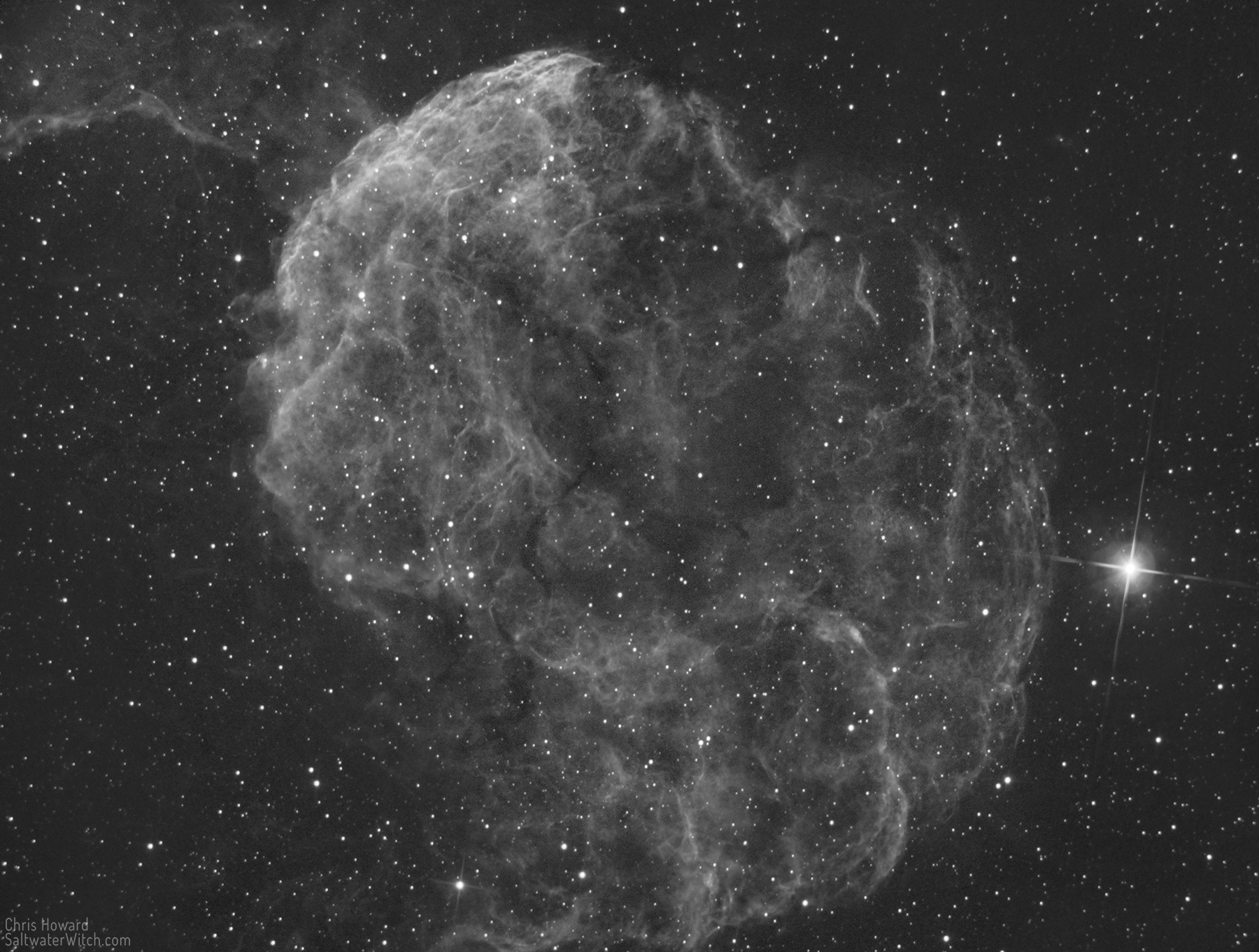M101 in Ursa Major
From my Sunday night astro imaging run: the Pinwheel Galaxy (M101, NGC 5457) is 21 million lightyears away in the constellation Ursa Major. It's quite a bit bigger than our own galaxy: a 170,000 lightyear diameter and a trillion stars. We're looking 21 million years back in time on this beautiful galaxy, tilted perfectly, face-on (or top-down?) from our perspective in the Milky Way, so that we can clearly see its spiral form, twisting dust lanes, HII regions, and other detailed structures. Space is big. And it takes that long for the light of a trillion suns to reach us from this distant galaxy. Imaging notes: about 6 hours of data, 70 x 300-second exposures with the ZWO ASI071 color camera cooled to -10C, UV/IR Cut filter, 800mm f/4 newtonian scope. With a 28.8 arc-minute apparent size, M101 is about the limit for deep sky targets with the 800mm focal length scope.
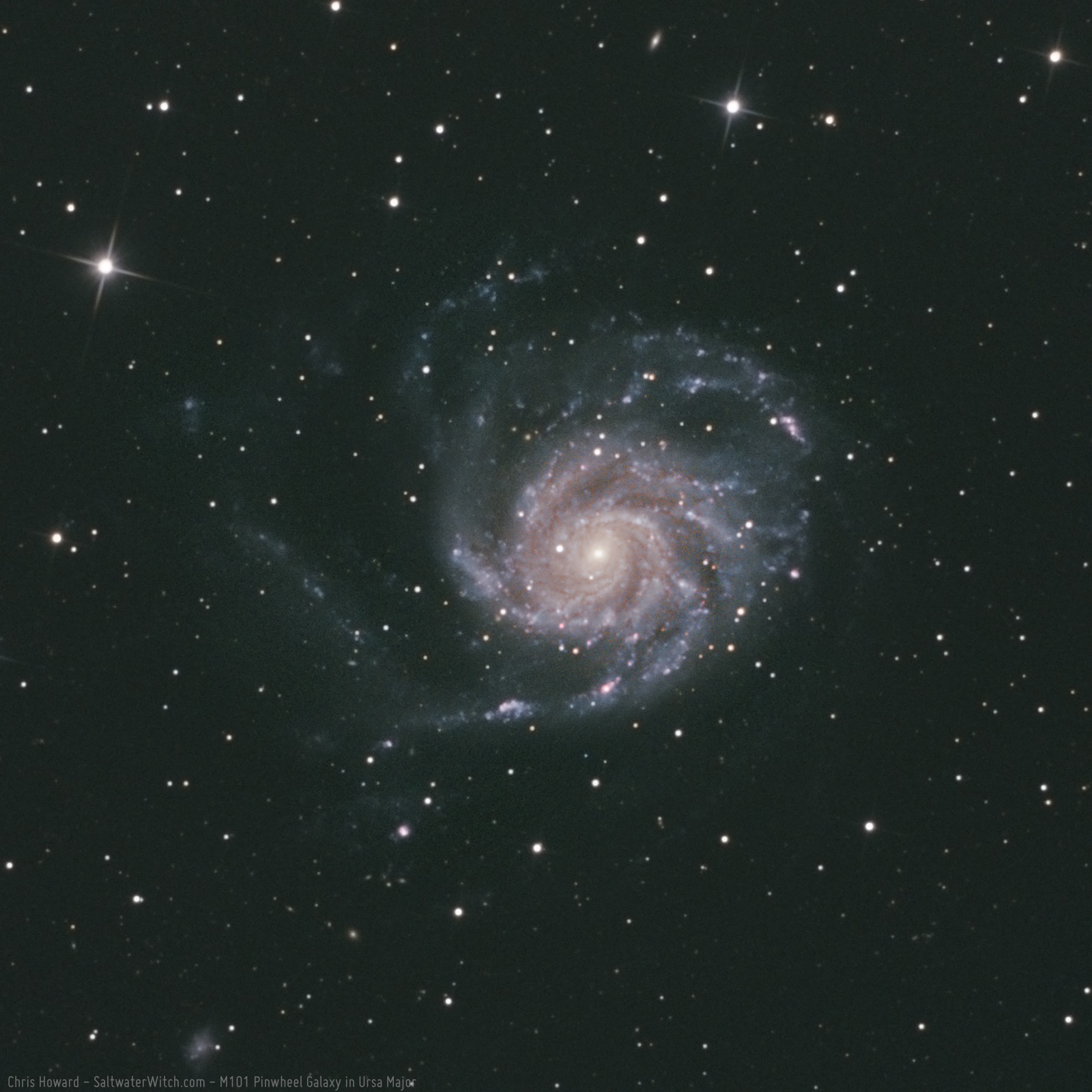
And here's the full image of M101, the Pinwheel Galaxy, slightly cropped to remove dithering artifacts at the top and side. What's crazy is there are at least a dozen other galaxies in this frame, most of them many more millions of lightyears distant than M101. All of the actual stars in this frame are within our own galaxy, the Milky Way. Everything else is another galaxy millions of lightyears away.

Posted May 15, 2023
NGC 7000 in Cygnus
I bought the Optolong L-eXtreme dual narrowband filter last year, but I haven't seriously used it until last night. Paired with the ZWO ASI071 and the 800mm f/4 Newtonian, I am pleasantly surprised with the data and processed image. The North America Nebula (NGC 7000) in the constellation Cygnus hit 30° above the horizon around midnight, and I spent over 3.5 hours capturing data, 45 x 300-second exposures stacked in DSS. This has to be the most efficient way to get to a bi-color narrowband image, using a single filter and color astronomy camera. These colors are also close to true in terms of where they are on the visible spectrum, with hydrogen-alpha in red and oxygen III in blue.

Posted May 14, 2023
Messier 5 and 5 Serpentis
The M5 globular cluster in the constellation Serpens (NGC 5904) might be the oldest globular cluster in our galaxy, somewhere around 13 billion years old, with the Milky Way itself almost as old as the universe at 13.61 billion years, forming just a few hundred million years after the Big Bang. M5 is about 27,000 lightyears away in the galactic halo, and is one of the largest clusters, with a diameter of about 165 lightyears. Imaging notes: 60 x 60-second subs with the ZWO ASI071MC cooled to -10C and the 800mm FL newtonian scope.
Take a closer look at the variable double star, 5 Serpentis, lower right with the diffraction spikes (the spikes are an artifact of some reflector telescopes, like the Hubble Space Telescope). If you look closely, you can see both stars, 5 Serpentis A is the larger of the two, with 5 Serpentis B just visible at the lower left of the main star. The main star (5 Serpentis A) is a large F-type main-sequence star, that has been fusing hydrogen like mad, has used most of it up, and is headed toward a red giant phase. Its companion, 5 Serpentis B, much smaller, has recently been estimated to have an orbital period of 3,371 years.
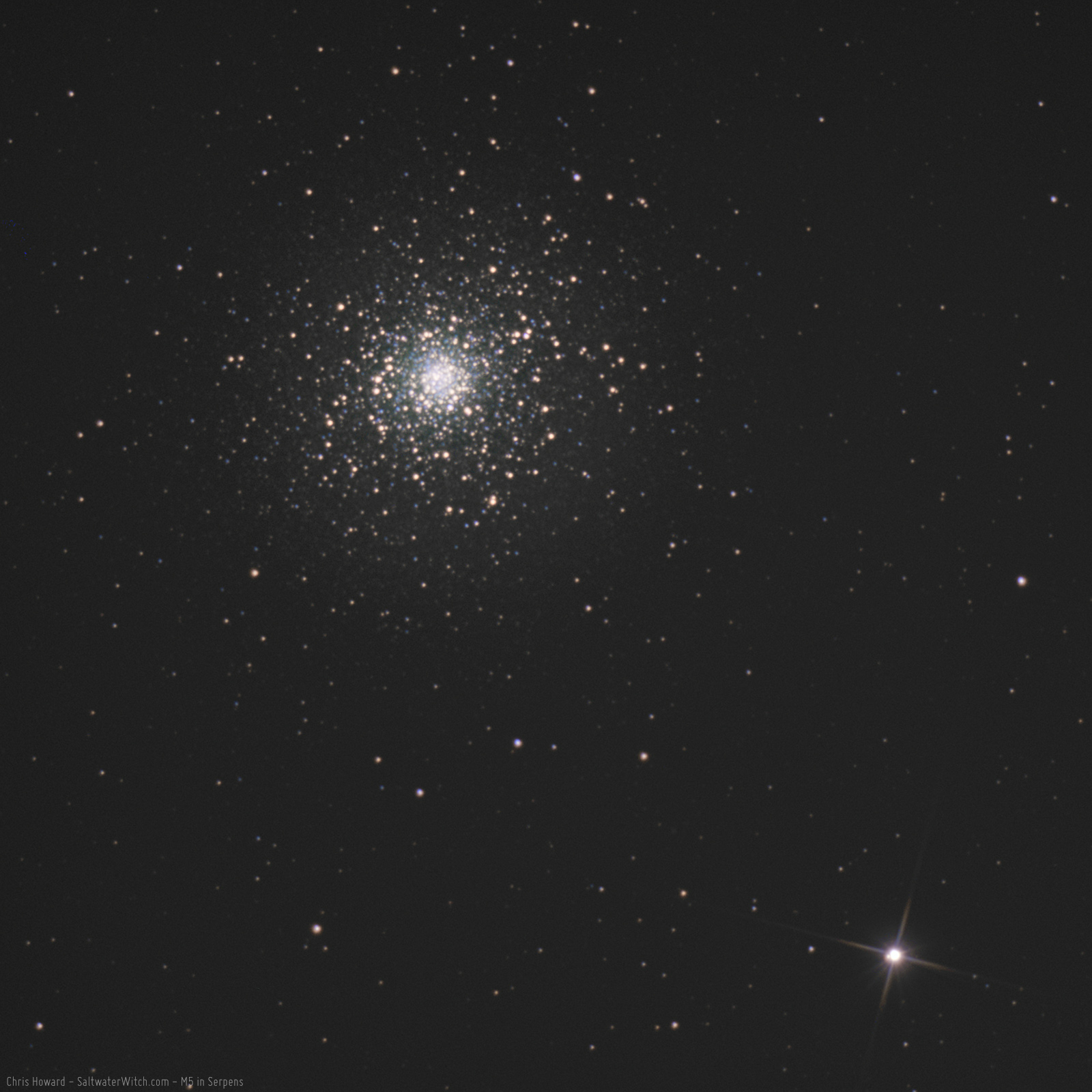
Posted May 11, 2023
What a Cluster!
From last night's imaging session: the massive star cluster, M13, NGC 6205, the Hercules Globular Cluster, is made up of hundreds of thousands of stars. Like most globular clusters, M13 is not found within the disk and spiral arm structures of the galaxy, but in the galactic halo, the outer spherical shape of the galaxy, above and below the galactic plane. M13 is about 145 lightyears in diameter. Notice the spiral galaxy on the lower left side--that's NGC 6207 (about 30 million lightyears away), with the far more distant galaxy IC 4617 (489 million LY!), just a tiny, faint smear between NGC6207 and the M13 globular cluster. Imaging notes: 800mm f/4 newtonian, ZWO ASI071MC cooled to -10C, 60 x 120-second exposures stacked in DSS.

Posted May 10, 2023
Tangled clouds in Cygnus
There's a lot going on in this detailed look at one tiny section of the vast network of interstellar dust and clouds of hydrogen in the constellation Cygnus, including the open star clusters NGC 6871, NGC 6883 and a handful of dark nebulae including Barnard 147 (LDN 853, the pointy dark channel of dust a little left of center), B146, LDN 856, 858. Notes: 28 x 8-minute exposures, almost four hours of data in hydrogen-alpha (Antlia 3nm Ha Pro filter), William Optics GT81 Apochromatic refractor 382mm FL at f/4.7, ZWO ASI1600MM-Pro mono camera cooled to -10C.

Cygnus Composite - I combined images from two different scopes, all the data for the wide field view (left) came from my William Optics GT81, and I captured the data for the Tulip Nebula (Sh2-101, right) with the Apertura 8"/203mm Newtonian.

Posted November 4, 2022
Narrowband Boogeyman in Orion
Sure, we're a few days late for halloween, but check out the creepiness of the dark molecular cloud LDN1622, the "Boogeyman Nebula" about 500 lightyears away in the constellation Orion, along with a bright lumpy backdrop of nebulosity lit from above by the variable star 56 Orionis. LDN1621 is the dark nebula to the left of the Boogeyman, and the reflection nebula VdB 62 is just to the right. The uneven cloudiness at the top right is a small section of Barnard's Loop (Sh2-276), which may give you an indication of LDN1622's location, on the other side of the Loop from M78, about halfway up one side of Orion. Notes: 36 x 8-minute exposures, almost five hours of data in hydrogen-alpha (Antlia 3nm Ha Pro filter), William Optics GT81 Apochromatic refractor 382mm FL at f/4.7, ZWO ASI1600MM-Pro mono camera cooled to -10C.

Posted November 4, 2022
M78 in RGB
I swapped out the narrowband EFW with the RGB+Ha filters, and ran through RGB for Messier 78 (NGC 2068), a reflection nebula in Orion. I also experimented with 2x2 binning with the ZWO ASI1600MM-Pro mono camera, and it taking the resolution from 0.98 arcseconds/pixel to 1.96" / pixel worked pretty well.
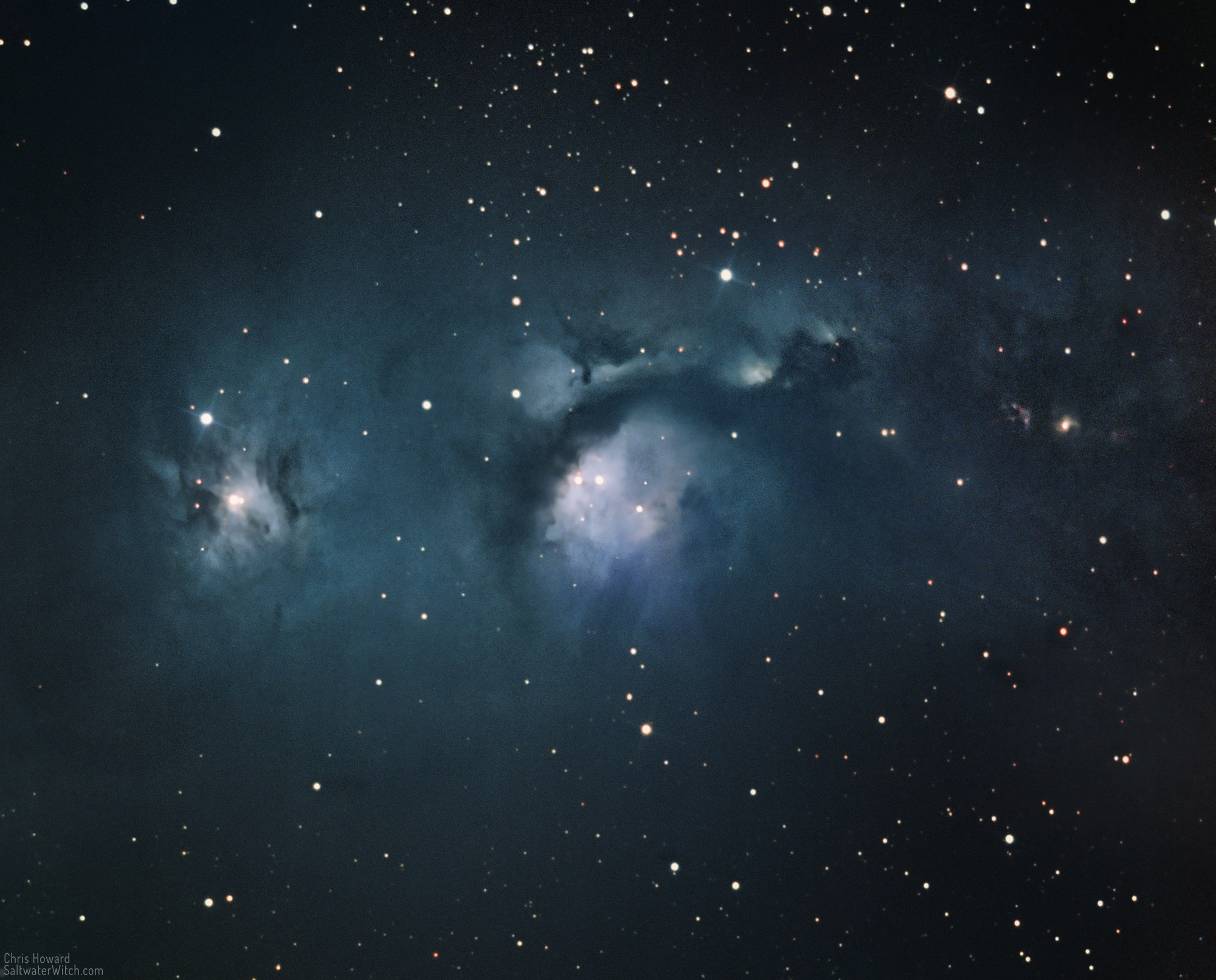
Posted October 30, 2022
A few more from this run of clear October skies
A few more processed (to some degree) images from the data I have gathered over the last five clear nights. Gear notes: I captured all the data for these in my backyard with an Apertura 800mm f/4 Newtonian OTA, ZWO ASI1600MM-Pro mono camera, Antlia 3nm filters, ZWO ASI290M OAG, on the Sky-Watcher EQ6R-Pro mount with the ZWO ASIAir Plus controller.
The core of the Heart Nebula (IC 1805) in Ha+OIII with the star cluster, Melotte 15 surrounding coils and branches of interstellar dust and gas.
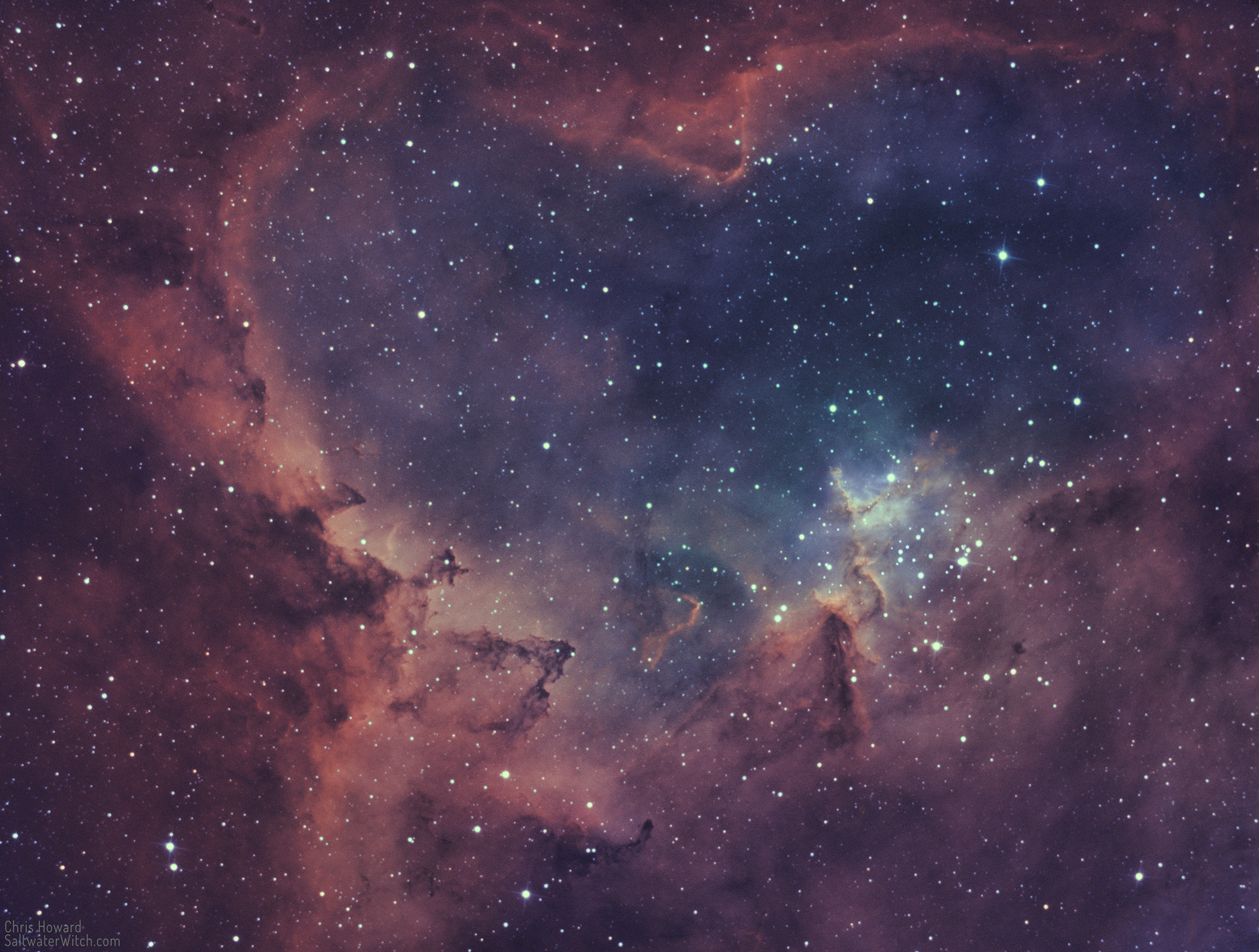
Here's the Tulip Nebula (Sharpless 101) in Ha + OIII, a very energetic HII region about 6000 lightyears away in the constellation Cygnus.
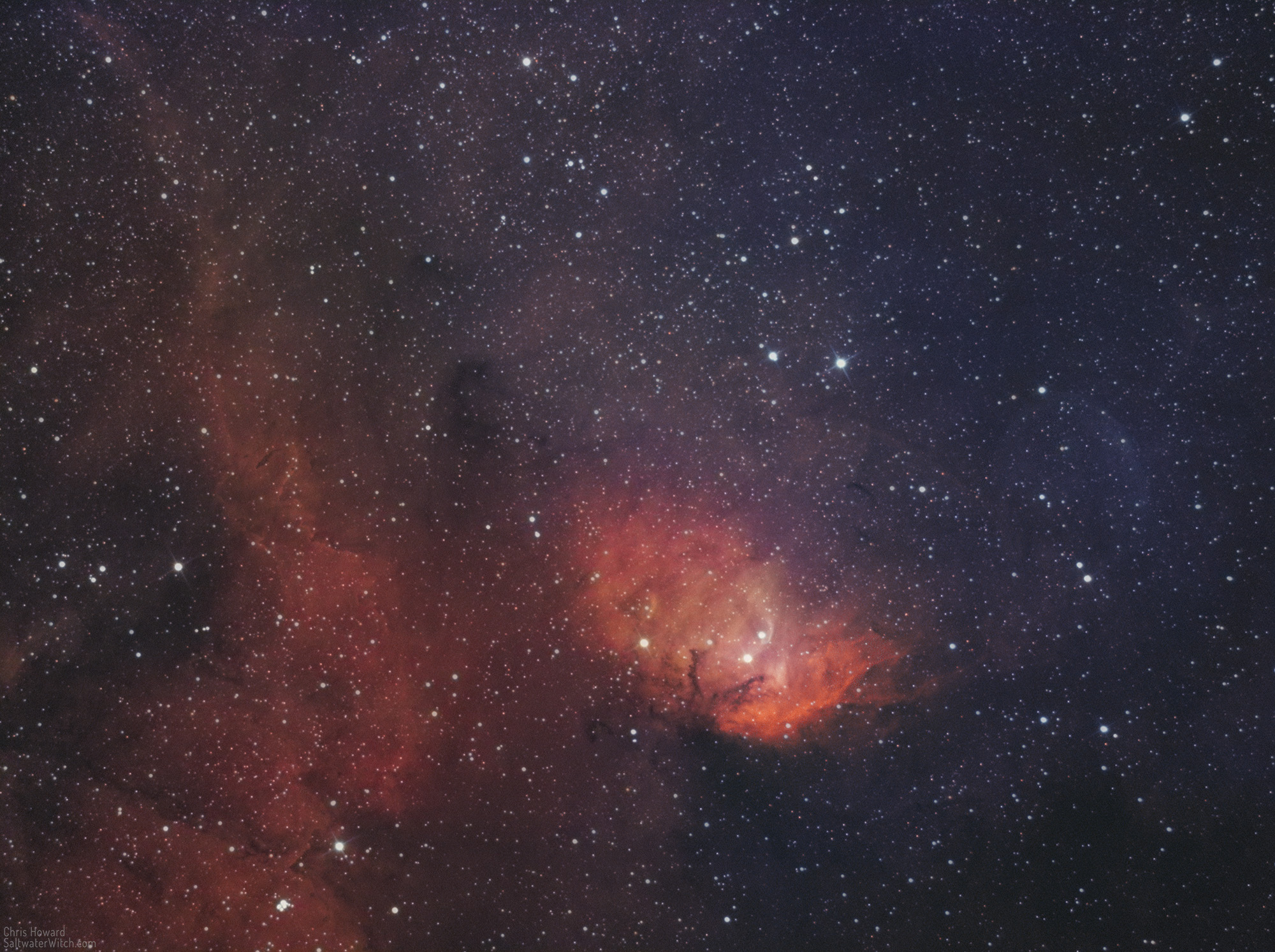
The Jellyfish Nebula (IC 443, Sharpless 248) in hydrogen-alpha. IC 443 is a (Sh2-248)) is a supernova remnant about 5000 lightyears away in the constellation Gemini. Trailing off, out of frame top left, is the HII region Sharpless 249. There's ongoing research to determine if these two interact, but they probably do not. SH2-249 is most likely further away than the IC 443 supernova remnant. [https://ui.adsabs.harvard.edu/abs/1984A%26A...140..395D]
